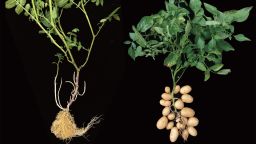Science
Wild Tomatoes in Galápagos Showcase Evidence of Reverse Evolution

In a groundbreaking discovery, researchers have observed a unique case of potential reverse evolution in wild tomatoes found on the Galápagos Islands, an area historically significant for Charles Darwin’s theory of evolution. The species, known scientifically as Solanum pennellii, has exhibited characteristics reminiscent of its ancient ancestors, raising intriguing questions about the flexibility of evolutionary processes.
Researchers first identified the peculiar traits of Solanum pennellii in June 2024 during a study investigating alkaloids—natural compounds that serve as a built-in pesticide for plants. Analyzing samples from various islands within the archipelago, they found that tomatoes from the younger, western islands were producing compounds not seen in tomato plants for millions of years. This contrasted sharply with their counterparts on the older eastern islands, which had developed modern defensive traits.
According to Adam Jozwiak, a molecular biochemist at the University of California, Riverside, these findings challenge commonly held beliefs about evolutionary progression. “It’s not very common to see reverse evolution,” he explained. The researchers published their findings in the journal Nature Communications, suggesting that environmental pressures may have prompted these tomatoes to revert to more ancient genetic traits.
The western tomatoes not only exhibited a different appearance—with purplish hues and darker vines—but also shared a molecular profile with eggplants, another member of the nightshade family. Modern tomatoes have lost the ability to produce eggplant alkaloids, yet those on the younger islands appear to have regained this ancestral trait.
By studying these unique molecular characteristics, scientists aim to enhance agricultural practices, potentially leading to improved crop resilience and pest management strategies. Jozwiak remarked that understanding these adaptations could inform broader insights into the evolutionary processes affecting various species, including humans.
The origins of Solanum pennellii trace back to South America, where it likely arrived in the Galápagos Islands carried by birds over a million years ago. The younger islands formed as a result of volcanic activity, and the evolution of these tomatoes must have occurred within the last 500,000 years, coinciding with the emergence of these islands.
The contrasting environments of the eastern and western islands play a significant role in the tomatoes’ development. The older islands boast a stable and biologically diverse ecosystem, while the younger islands feature harsher conditions with less developed soil. Jozwiak hypothesizes that the ancient alkaloid production not only aids in deterring predators but also enhances nutrient absorption and disease resistance.
While Jozwiak and his team have begun to unravel the genetic changes behind this reversal, further research is necessary to understand fully the implications of these findings. The simple alteration in the amino acid composition that prompted this shift raises questions about the underlying evolutionary mechanisms.
The concept of reverse evolution is contentious among evolutionary biologists. Anurag Agrawal, an evolutionary ecologist at Cornell University, noted that while the idea may seem surprising, evolution is not strictly linear. He cited various examples in nature, such as the loss of flight in certain birds and the reversion of aquatic mammals to a more streamlined form, to illustrate that evolutionary paths can diverge and converge in unexpected ways.
While the research challenges the established notion known as Dollo’s Law, which posits that lost traits cannot be regained in the same form, it opens new avenues for understanding how species adapt under varying environmental pressures. Eric Haag, a biology professor at the University of Maryland, emphasized the interest in how specific amino acid changes in the Galápagos tomatoes align with more distant ancestors.
The implications of this research extend beyond botany. Jozwiak posited that a deeper understanding of evolutionary flexibility could illuminate the potential for humans to exhibit similar genetic reversions, as seen in rare cases of congenital traits.
While the alkaloids in high concentrations are not safe for human consumption, the wild tomatoes currently pose no health risks as they are not cultivated for food. Jozwiak hopes to return to the Galápagos to explore further the interactions between the tomatoes and their environment, particularly how the ancestral molecules influence their relationships with insects and decomposition rates.
The emerging narrative of reverse evolution invites a reevaluation of long-held beliefs about the directionality of evolutionary change. As research progresses, it may reshape our understanding of how species adapt, survive, and occasionally revert, highlighting the intricate dance of nature’s evolutionary mechanisms.
-

 Science2 weeks ago
Science2 weeks agoResearchers Challenge 200-Year-Old Physics Principle with Atomic Engines
-

 Politics2 weeks ago
Politics2 weeks agoNHP Foundation Secures Land for 158 Affordable Apartments in Denver
-

 World5 days ago
World5 days agoBoeing’s Aircraft Production: Assessing Numbers and Challenges
-

 Entertainment5 days ago
Entertainment5 days agoSyracuse Stage Delivers Lively Adaptation of ‘The 39 Steps’
-

 Health2 weeks ago
Health2 weeks agoNeuroscientist Advocates for Flag Football Until Age 14
-

 Lifestyle2 weeks ago
Lifestyle2 weeks agoLongtime Friends Face Heartbreak After Loss and Isolation
-

 Lifestyle4 days ago
Lifestyle4 days agoTrump’s Push to Censor National Parks Faces Growing Backlash
-

 Science5 days ago
Science5 days agoAI Misidentifies Doritos Bag as Gun, Triggers Police Response
-

 World2 weeks ago
World2 weeks agoGlobal Military Spending: Air Forces Ranked by Budget and Capability
-

 Lifestyle5 days ago
Lifestyle5 days agoRed Bluff High School’s Elli Nolan Named Rotary Student of the Month
-

 Health2 weeks ago
Health2 weeks agoFDA Launches Fast-Track Review for Nine Innovative Therapies
-

 Business2 weeks ago
Business2 weeks agoSpirit Airlines Cuts Workforce with Furloughs for 365 Pilots









